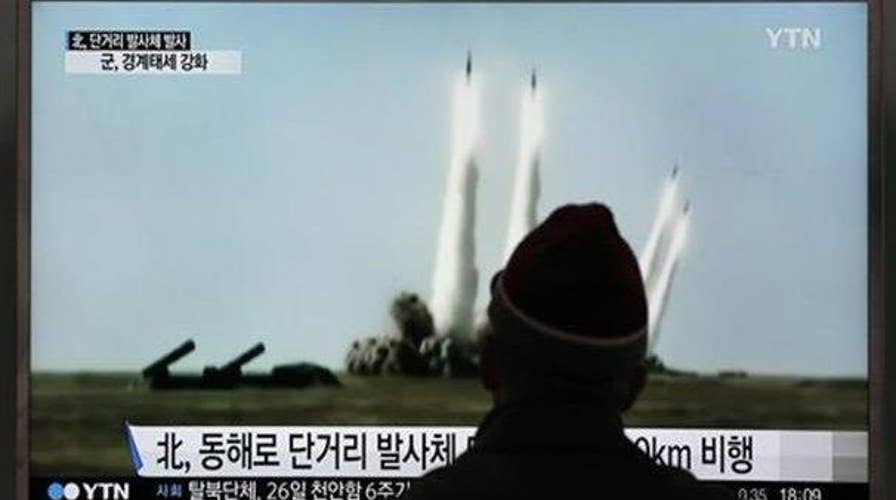North Korea trying to extend its missile strike range?
Insight from Asia analyst and author Gordon Chang
SEOUL, South Korea – North Korean leader Kim Jong Un trumpeted the success of a powerful new midrange ballistic missile test that state media said Thursday propelled one of the weapons more than 870 miles high, saying it would allow strikes on U.S. forces throughout the region.
That ability would back up years of threats and boasts from North Korea and has long been a worry for the United States and its allies, Tokyo and Seoul. It explains in part North Korea's tenacious testing of the Musudan missile, which was only a success after five failures in about two months. The missile's potential 2,180-mile range puts much of Asia and the Pacific within reach.
After observing the launch, Kim said it gives his country the "sure capability to attack in an overall and practical way the Americans in the Pacific operation theatre," according to the official Korean Central News Agency.
Other governments said North Korea fired two Musduan missiles on Wednesday, after suffering four previous launch failures since April.
The first launch ended in failure. But Japanese Defense Minister Gen Nakatani said the second launch demonstrated a "certain level of capability," and could lead to a further strengthening of North Korea's ballistic missile capabilities that can cover Japanese territory.
Each new test — apparently linked to a command from Kim — likely provides valuable insights to North Korea's scientists and military officials as they push toward their goal of a nuclear and missile program that can threaten the U.S. mainland. Pyongyang earlier this year conducted a nuclear test, its fourth, and launched a long-range rocket that outsiders say was a cover for a test of banned missile technology.
A statement from South Korea's Joint Chiefs of Staff said the suspected first Musudan launch Wednesday from the east coast city of Wonsan failed. It didn't elaborate, but Japan's Defense Ministry said the missile fragmented and pieces fell into waters off the Korean Peninsula's east coast.
Later Wednesday, the South's military said the North fired another suspected Musudan, which flew about 400 kilometers (245 miles).
The KCNA report said the missile flew to the maximum height of 878.3 miles before landing 400 kilometers away in waters the North had targeted.
"We have to see it as a success," Lee Choon Geun, an analyst at South Korea's state-funded Science and Technology Policy Institute, said of the second launch. "No other (previous) missiles fired by North Korea have ever flown that high."
The U.S. Strategic Command in Hawaii said Wednesday its systems detected and tracked two suspected North Korean Musudan missiles that fell into the Sea of Japan.
In April, North Korea attempted unsuccessfully to launch three suspected Musudan missiles, but all exploded midair or crashed, according to South Korean defense officials. Earlier this month, North Korea had another suspected Musudan failure, they said.
Before April's launches, North Korea had never flight-tested a Musudan missile, although one was displayed during a military parade in 2010 in Pyongyang.
Musudan is named by outsiders after a village near its test site. The KCNA report called it a Hwasong-10.
The launches appear to stem from Kim's order in March for more nuclear and ballistic missile tests. The order was an apparent response to springtime U.S.-South Korean military drills, which North Korea views as an invasion rehearsal.
In the KCNA report, Kim said North Korea must bolster its pre-emptive nuclear attack capability to cope with U.S. threats and continue the development of strategic weapons systems.
"We're very pleased because we now can confidently cope with whatever nuclear war the U.S. launches" on the North, North Korean diplomat Choe Son Hui told reporters in Beijing on Thursday, after attending a security forum.
The string of recent launch attempts shows the North is pushing hard to upgrade its missile capability in defiance of U.S.-led international pressure. The North was slapped with the strongest U.N. sanctions in two decades after its nuclear test and long-range rocket launch earlier this year.
"The impact of these provocations will be to only strengthen the resolve of the international community that has such serious concerns with North Korea's behavior," said White House spokesman Josh Earnest. "The United States will do what we have done in the past, which is work with the international community, particularly our allies in South Korea and Japan."
South Korea's Defense Minister Han Min Koo on Thursday called the launches a "grave threat" and warned that North Korea will face tougher sanctions. In Tokyo, Prime Minister Shinzo Abe was also critical, saying, "We find it utterly unforgivable."
Chinese Foreign Ministry spokeswoman Hua Chunying said that Beijing didn't consider the missile launches to be an act of defiance against China, North Korea's long-time ally with whom its relations have cooled substantially in recent years.
"To say such an act taken by North Korea shows disapproval against China is reading too much into it," Hua said at a press briefing.
North Korea has recently claimed a series of breakthroughs in its push to build a long-range nuclear missile that can strike the American mainland. But South Korean officials have said the North doesn't yet possess such a weapon.
The North, however, has already deployed a variety of missiles that can reach most targets in South Korea and Japan, including American military bases in those countries.
The Korean Peninsula remains in a technical state of war because the 1950-53 Korean War ended with an armistice, not a peace treaty. About 28,500 U.S. soldiers are stationed in South Korea to deter possible aggression from North Korea; tens of thousands more are stationed in Japan.

